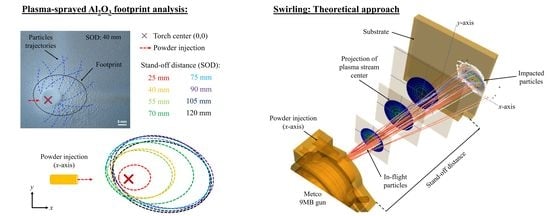Swirling Effects in Atmospheric Plasma Spraying Process: Experiments and Simulation
Abstract
1. Introduction
2. Materials and Methods
2.1. Dynamic and Static Footprints
2.2. Mathematical Modeling
3. Results and Discussion
3.1. Static and Dynamic Spray Footprints
3.2. Theoretical Validation of Swirl
4. Conclusions
Author Contributions
Funding
Acknowledgments
Conflicts of Interest
References
- Fauchais, P.L.; Heberlein, J.V.R.; Boulos, M.I. Thermal Spray Fundamentals; Springer: New York, NY, USA, 2014; ISBN Print ISBN 978-0-387-28319-7 Online ISBN 978-0-387-68991-3. [Google Scholar]
- Tendero, C.; Tixier, C.; Tristant, P.; Desmaison, J.; Leprince, P. Atmospheric pressure plasmas: A review. Spectrochim. Acta Part B At. Spectrosc. 2006, 61, 2–30. [Google Scholar] [CrossRef]
- Vassen, R.; Jarligo, M.O.; Steinke, T.; Mack, D.E.; Stoever, D. Overview on advanced thermal barrier coatings. Surf. Coat. Technol. 2010, 205, 938–942. [Google Scholar] [CrossRef]
- Rivera-Gil, M.A.; Gomez-Chavez, J.J.; Ramana, C.V.; Naraparaju, R.; Schulz, U.; Muñoz-Saldaña, J. High temperature interaction of volcanic ashes with 7YSZ TBC’s produced by APS: Infiltration behavior and phase stability. Surf. Coat. Technol. 2019, 378, 124915. [Google Scholar] [CrossRef]
- Hui, R.; Wang, Z.; Kesler, O.; Rose, L.; Jankovic, J.; Yick, S.; Maric, R.; Ghosh, D. Thermal plasma spraying for SOFCs: Applications, potential advantages, and challenges. J. Power Sources 2007, 170, 308–323. [Google Scholar] [CrossRef]
- Gage, R.M. Arc Torch and Process. U.S. Patent 2806124, 10 September 1957. [Google Scholar]
- Zehavi, R. Hybrid Nozzle for Plasma Spraying Silicon. U.S. Patent 8253058, 29 August 2012. [Google Scholar]
- Shang, S.; Guduri, B.; Cybulsky, M.; Batra, R.C. Effect of turbulence modulation on three-dimensional trajectories of powder particles in a plasma spray process. J. Phys. D Appl. Phys. 2014, 47, 405206. [Google Scholar] [CrossRef]
- Chyou, Y.P.; Pfender, E. Behavior of particulates in thermal plasma flows. Plasma Chem. Plasma Process. 1989, 9, 45–71. [Google Scholar] [CrossRef]
- Williamson, R.L.; Fincke, J.R.; Chang, C.H. A Computational Examination of the Sources of Statistical Variance in Particle Parameters During Thermal Plasma Spraying. Plasma Chem. Plasma Process. 2000, 20, 299–324. [Google Scholar] [CrossRef]
- Spores, R.; Pfender, E. Flow structure of a turbulent thermal plasma jet. Surf. Coat. Technol. 1989, 37, 251–270. [Google Scholar] [CrossRef]
- Li, H.P.; Chen, X. Three-Dimensional Modeling of the Turbulent Plasma Jet Impinging upon a Flat Plate and with Transverse Particle and Carrier-Gas Injection. Plasma Chem. Plasma Process. 2002, 22, 27–58. [Google Scholar] [CrossRef]
- Li, H.P.; Pfender, E. Three dimensional modeling of the plasma spray process. J. Therm. Spray Technol. 2007, 16, 245–260. [Google Scholar] [CrossRef]
- Westhoff, R. Modeling the Non-Transfer Arc Plasma Torch and Plume for Plasma Processing. Ph.D. Thesis, Massachusetts Institute of Technology MIT, Cambridge, MA, USA, 1992. [Google Scholar]
- Zhou, Q.; Yin, H.; Li, H.; Xu, X.; Liu, F.; Guo, S.; Chang, X.; Guo, W.; Xu, P. The effect of plasma-gas swirl flow on a highly constricted plasma cutting arc. J. Phys. D Appl. Phys. 2009, 42, 095208. [Google Scholar] [CrossRef]
- Kang, K.D.; Hong, S.H. Numerical analysis of shroud gas effects on air entrainment into thermal plasma jet in ambient atmosphere of normal pressure. J. Appl. Phys. 1999, 85, 6373–6380. [Google Scholar] [CrossRef]
- McKelliget, J.; Trapaga, G.; Gutierrez-Miravete, A.; Cybulsky, M. An Integrated Mathematical Model of the Plasma Spraying Process. In Proceedings of the International Thermal Spray Conference, Nice, France, 25–29 May 1998; pp. 335–340. [Google Scholar]
- Boulos, M.I.; Fauchais, P.; Pfender, E. Thermal Plasmas: Fundamentals and Applications; Springer: New York, NY, USA, 1994; ISBN 978-1-4899-1339-5. [Google Scholar]
- El-Kaddah, N.; McKelliget, J.; Szekely, J. Heat transfer and fluid flow in plasma spraying. Metall. Trans. B 1984, 15, 59–70. [Google Scholar] [CrossRef]
- Paik, S.; Chen, X.; Kong, P.; Pfender, E. Modeling of a counterflow plasma reactor. Plasma Chem. Plasma Process. 1991, 11, 229–249. [Google Scholar] [CrossRef]
- Westhoff, R.; Trapaga, G.; Szekely, J. Plasma-particle interactions in plasma spraying systems. Metall. Trans. B 1992, 23, 683–693. [Google Scholar] [CrossRef]
- Chen, X.; Pfender, E. Heat transfer to a single particle exposed to a thermal plasma. Plasma Chem. Plasma Process. 1982, 2, 185–212. [Google Scholar] [CrossRef]
- Mckelliget, J.W.; El-Kaddah, E.N. A mathematical model of the spheroidization of porous agglomerate particles in thermal plasma torches. Therm. Appl. Mater. Metall. Process. 1992, 337–349. [Google Scholar]
- Yates, R.D.; Goodman, D.J. Probability and Stochastic Processes: A Friendly Introduction for Electrical and Computer Engineers, 1st ed.; John Wiley & Sons: New York, NY, USA, 1998; ISBN 0471178373. [Google Scholar]
- Kothe, D.B.; Mjolsness, R.C. RIPPLE—A new model for incompressible flows with free surfaces. AIAA J. 1992, 30, 2694–2700. [Google Scholar] [CrossRef]
- Fauchais, P. Understanding plasma spraying. J. Phys. D Appl. Phys. 2004, 37, R86–R108. [Google Scholar] [CrossRef]
- Bobzin, K.; Öte, M.; Knoch, M.A.; Alkhasli, I. Macroscopic particle modeling in air plasma spraying. Surf. Coat. Technol. 2019, 364, 449–456. [Google Scholar] [CrossRef]
- Frank, M. White Fluid Mechanics, 7th ed.; McGraw-Hill: New York, NY, USA, 2011. [Google Scholar]
- Bobzin, K.; Öte, M.; Knoch, M.A.; Heinemann, H. Influence of the injector head geometry on the particle injection in plasma spraying. J. Therm. Spray Tech. 2020, 29, 534–545. [Google Scholar] [CrossRef]
- Fan, W.; Bai, Y. Review of suspension and solution precursor plasma sprayed thermal barrier coatings. Ceram. Int. 2016, 42, 14299–14312. [Google Scholar] [CrossRef]
- Georgiopoulos, I.; Vourdas, N.; Mirza, S.; Stathopoulos, V. LaAlO3 as overlayer in conventional thermal barrier coatings. Procedia Struct. Integr. 2018, 10, 280–287. [Google Scholar] [CrossRef]
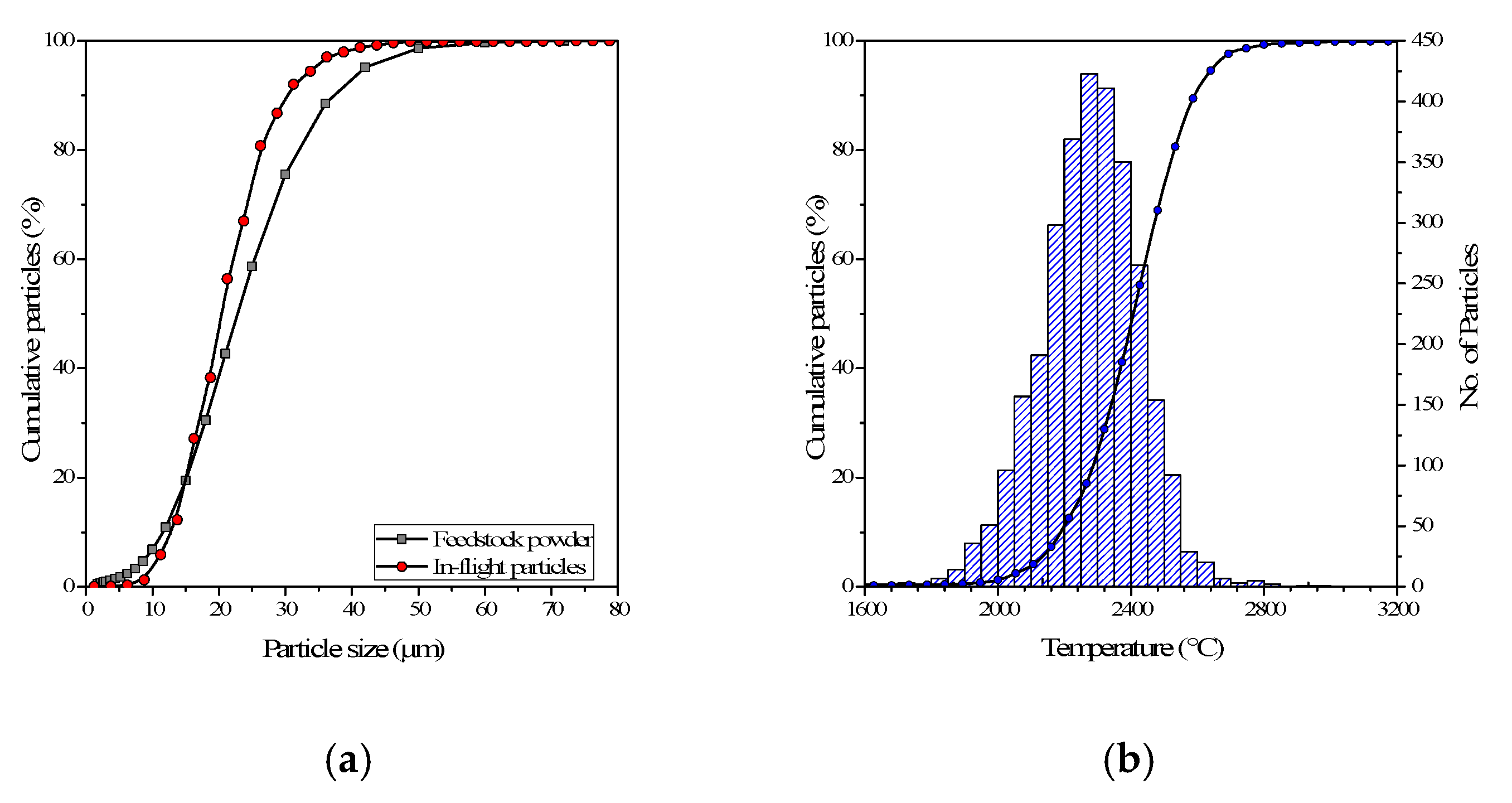
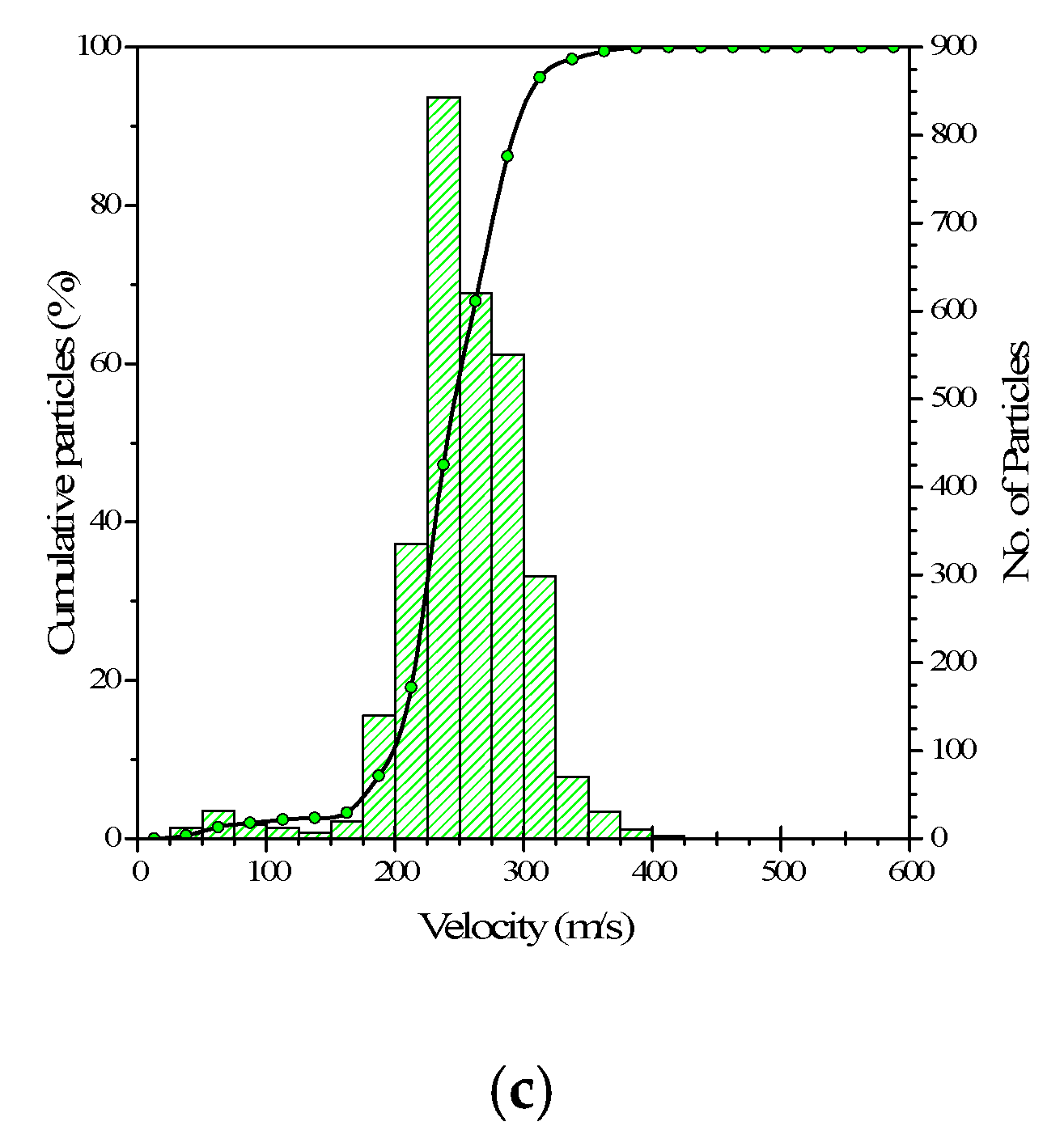
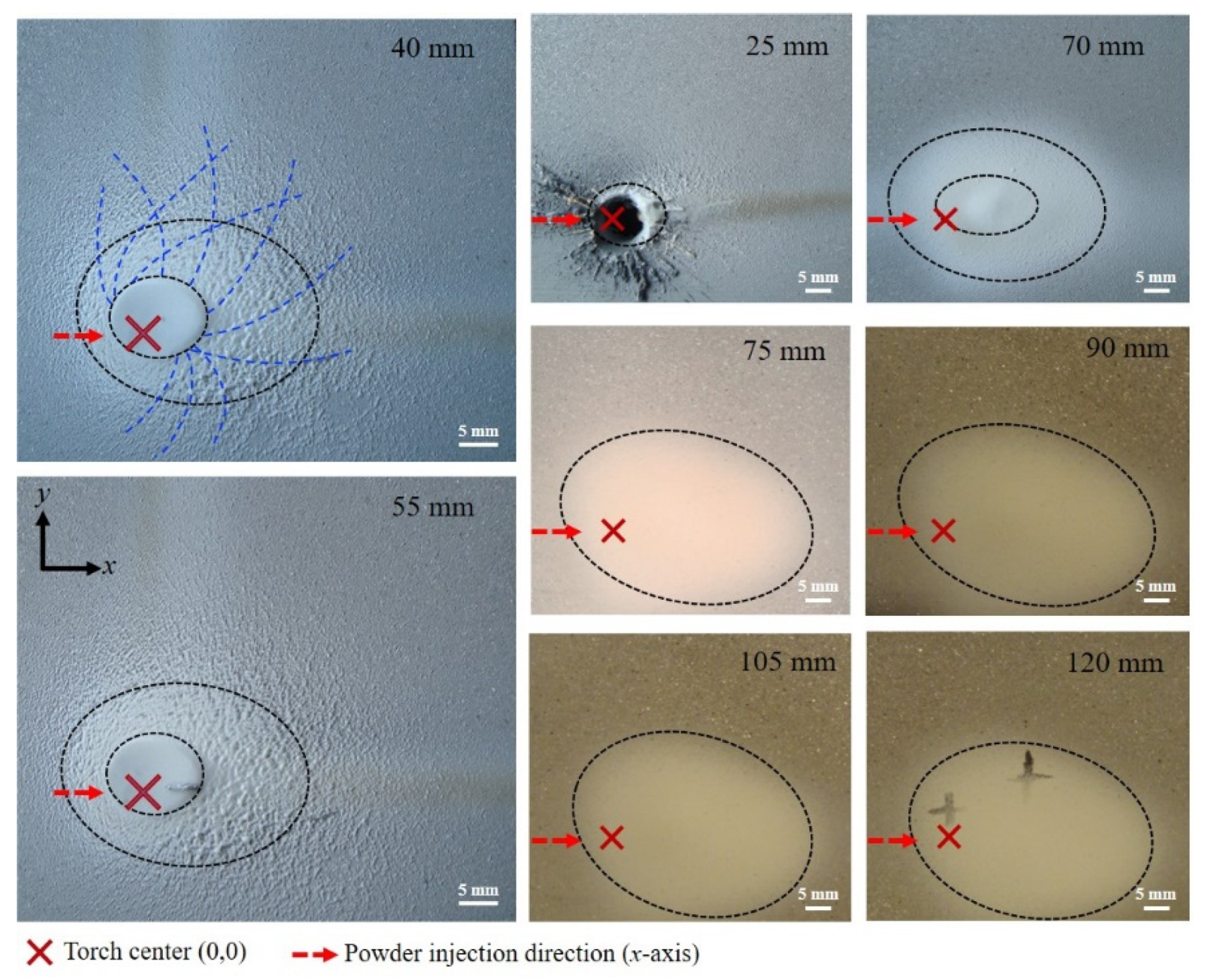
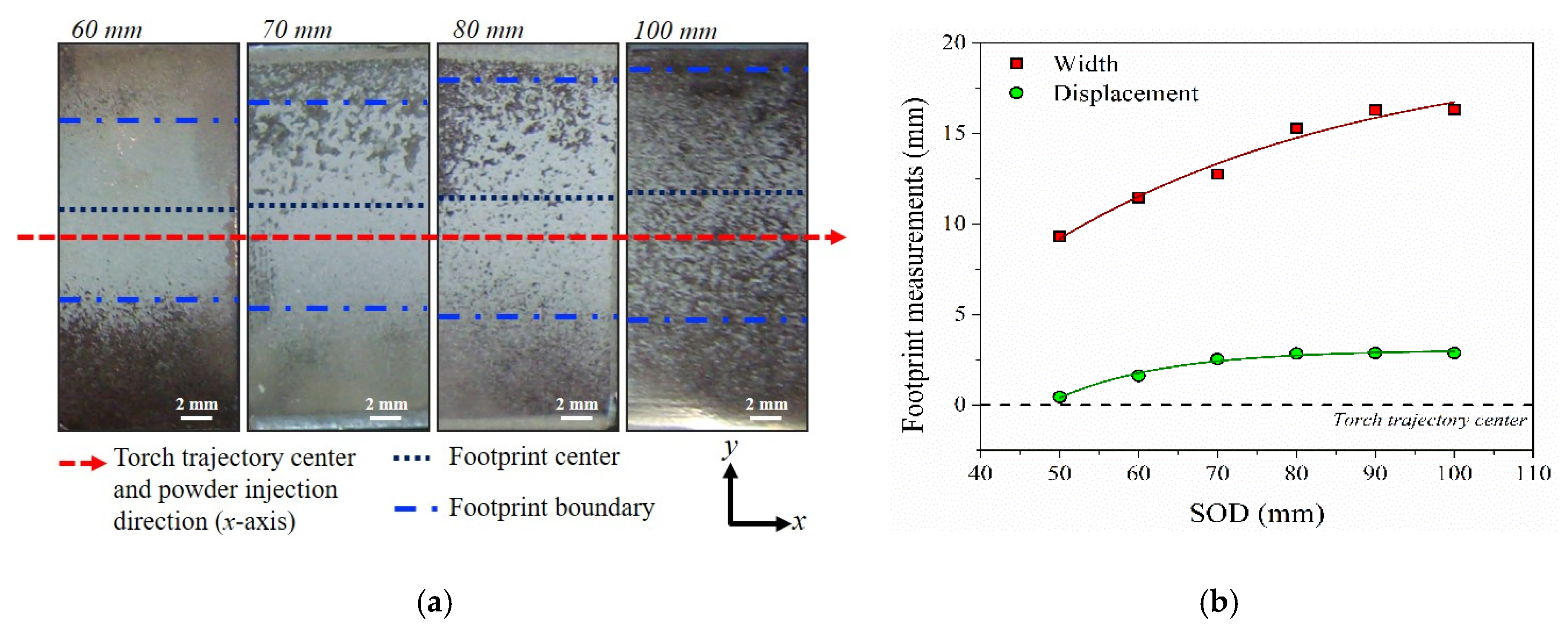
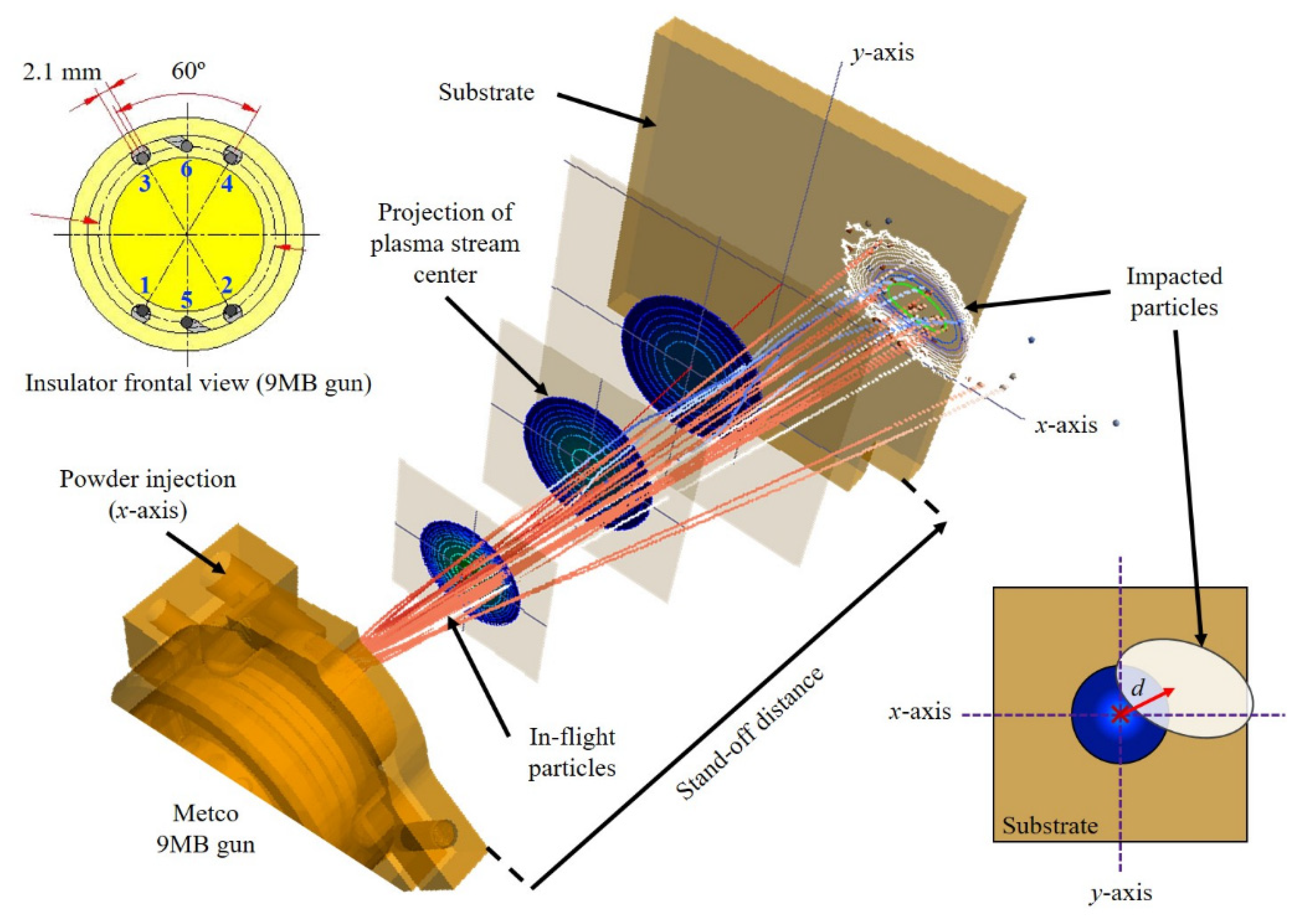
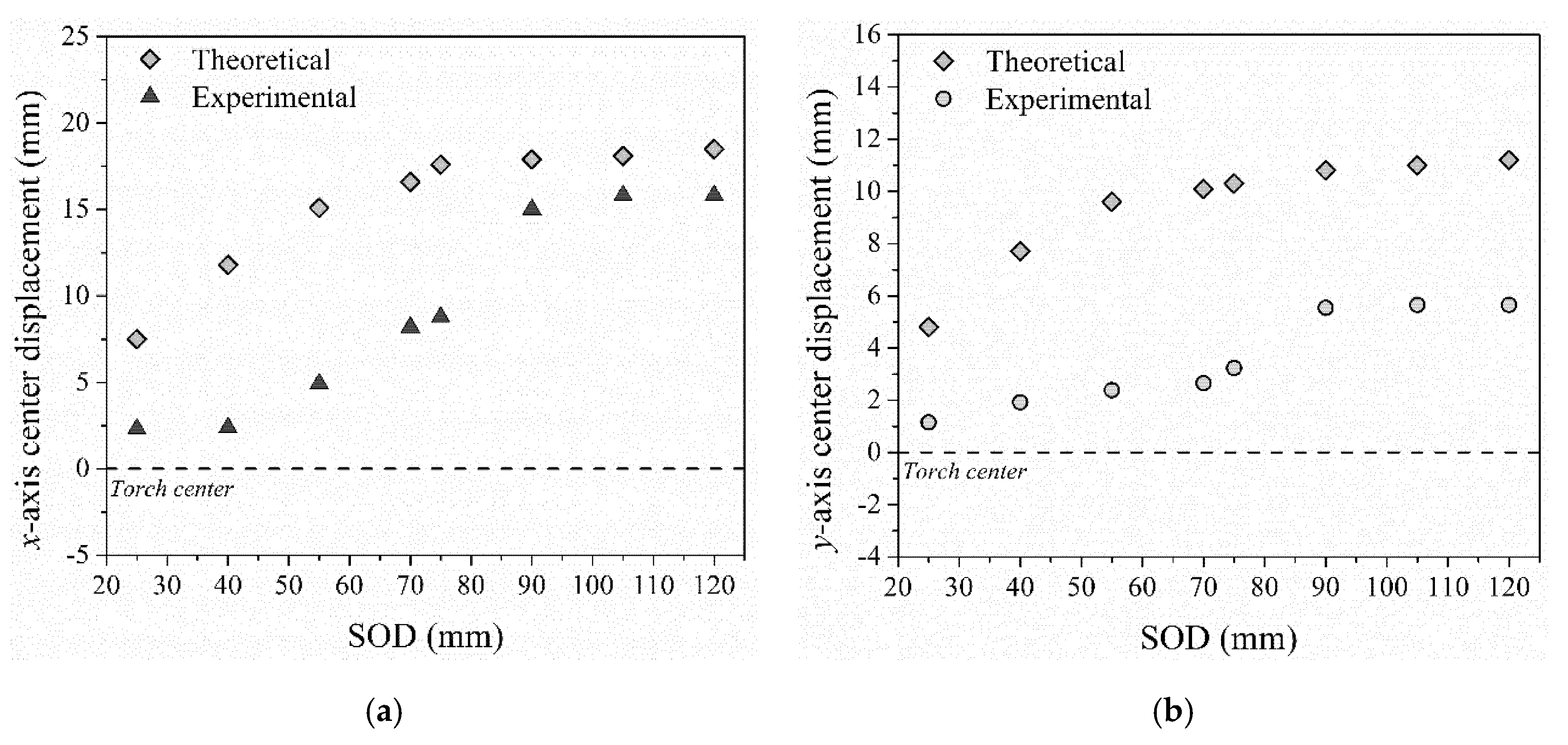
© 2020 by the authors. Licensee MDPI, Basel, Switzerland. This article is an open access article distributed under the terms and conditions of the Creative Commons Attribution (CC BY) license (http://creativecommons.org/licenses/by/4.0/).
Share and Cite
Martínez-Villegas, I.; Mora-García, A.G.; Ruiz-Luna, H.; McKelliget, J.; Poblano-Salas, C.A.; Muñoz-Saldaña, J.; Trápaga-Martínez, G. Swirling Effects in Atmospheric Plasma Spraying Process: Experiments and Simulation. Coatings 2020, 10, 388. https://doi.org/10.3390/coatings10040388
Martínez-Villegas I, Mora-García AG, Ruiz-Luna H, McKelliget J, Poblano-Salas CA, Muñoz-Saldaña J, Trápaga-Martínez G. Swirling Effects in Atmospheric Plasma Spraying Process: Experiments and Simulation. Coatings. 2020; 10(4):388. https://doi.org/10.3390/coatings10040388
Chicago/Turabian StyleMartínez-Villegas, Israel, Alma G. Mora-García, Haideé Ruiz-Luna, John McKelliget, Carlos A. Poblano-Salas, Juan Muñoz-Saldaña, and Gerardo Trápaga-Martínez. 2020. "Swirling Effects in Atmospheric Plasma Spraying Process: Experiments and Simulation" Coatings 10, no. 4: 388. https://doi.org/10.3390/coatings10040388
APA StyleMartínez-Villegas, I., Mora-García, A. G., Ruiz-Luna, H., McKelliget, J., Poblano-Salas, C. A., Muñoz-Saldaña, J., & Trápaga-Martínez, G. (2020). Swirling Effects in Atmospheric Plasma Spraying Process: Experiments and Simulation. Coatings, 10(4), 388. https://doi.org/10.3390/coatings10040388





